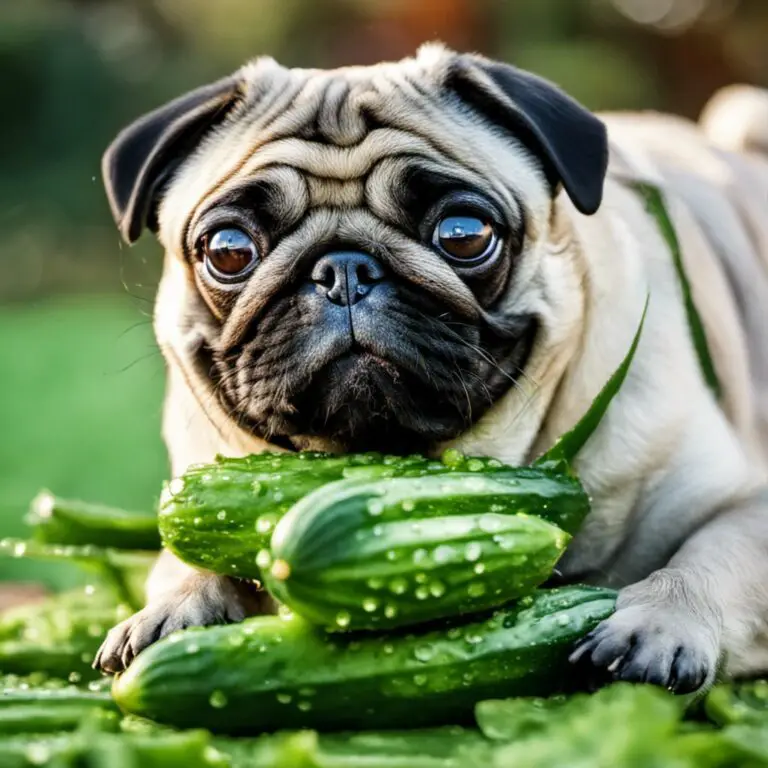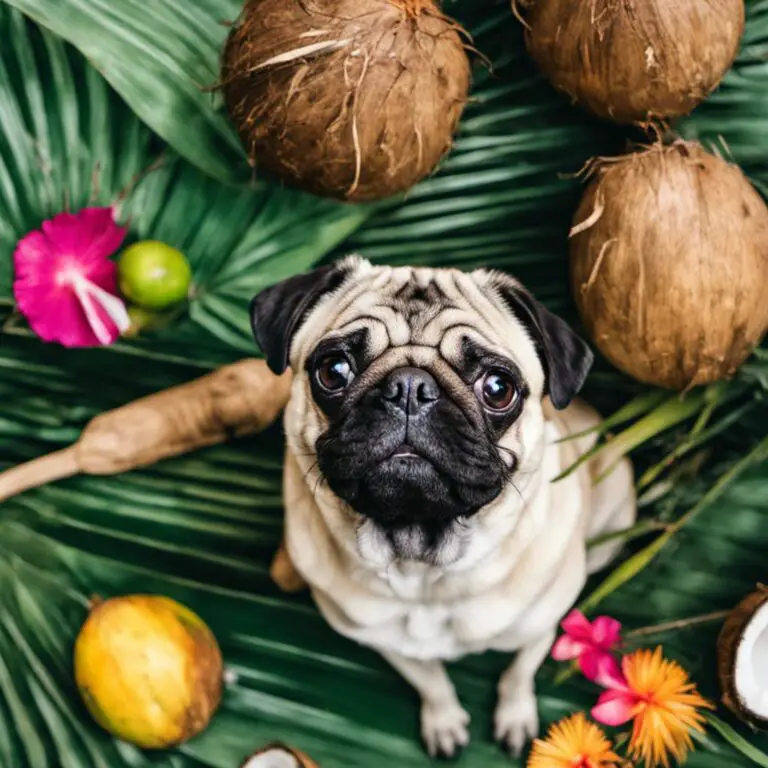Can Pugs Eat Pumpkin? A Clear Guide for Pet Owners

As a pug owner, you might be curious about what types of food you can safely share with your four-legged friend. One of the popular food questions that often arises is, Can Pugs Eat Papaya? It’s important to know whether pugs can consume pumpkin and if they have added health benefits.

The good news is, yes, pugs can eat pumpkin. In fact, pumpkin offers multiple health benefits for your pug, including weight loss and added fiber. Small amounts of pumpkin can help pugs who are prone to obesity shed excess weight without increasing their overall calorie intake, as they feel fuller more easily source. Additionally, pumpkins contain vitamins and nutrients, like potassium, that can boost your pug’s overall health.
So, don’t be afraid to add some pumpkin to your pug’s diet! Ensure you give them moderate portions and consult your veterinarian for accurate feeding guidelines.
Contents
Table of Contents
What Are Pugs and Their Dietary Needs

Pugs are a small, lovable breed of dog known for their wrinkly faces and distinctive snorts. As a pug owner, you must ensure your pet gets a balanced diet to stay healthy and happy. Your pug’s diet should generally contain adequate amounts of protein, fat, fiber, vitamins, and minerals.
Get The Free Food Eating Guide That Keeps My Pug Happy and Playful Even at 13 Years Old
100% Beginner Friendly & Lists Real Foods Your Pug Can Actually Eat!

Protein is essential for the growth and repair of your pug’s muscles, while fat is vital for providing energy and maintaining healthy skin and coat. Fiber plays a crucial role in pug’s digestion, helping prevent constipation and maintaining a healthy gut. Your pug also needs vitamins and minerals to support its immune system, bone health, and overall well-being.
One common issue with pugs is obesity. Their small size and adorable appearance may lead you to overfeed them. However, this can contribute to various health issues like joint problems and heart disease. Maintaining a consistent meal schedule, offering proper portions, and providing healthy treats can help prevent obesity in your pug.
When it comes to feeding your pug, also consider including fruits and vegetables, as they offer essential nutrients that contribute to overall health. One such food to consider in your pug’s diet is pumpkin. Pumpkin is deemed a superfood for pets, with numerous benefits such as aiding digestion, urinary health, and weight management.
In summary, it is essential to maintain a balanced, nutrient-rich diet for your pug that considers its specific needs, including protein, fat, fiber, vitamins, minerals, and healthy fruits and vegetables like pumpkin. Keep an eye on your pug’s weight to prevent obesity-related health issues and ensure they have a healthy and happy life.
Understanding Pumpkin as a Food Option

When considering pumpkin as a food option for your pug, it’s essential to understand its nutritional value and potential benefits. Pumpkin is packed with essential nutrients like vitamin A, vitamin C, iron, potassium, and fiber. It also contains antioxidants, making it a healthy and nutritious choice.
Pumpkin has a high water content, which can help keep your pug hydrated. With its low-calorie count, incorporating pumpkin into your pet’s diet can aid in weight loss for pugs who tend to be overweight or obese. Additionally, the fiber in pumpkin promotes healthy digestion and can prevent constipation.
One of pumpkin’s more noteworthy nutrients is beta-carotene. This antioxidant is converted into vitamin A in the body, which plays a critical role in maintaining healthy vision, skin, and immune system function. Vitamin C in pumpkin also contributes to the health of your pug’s immune system and may even help reduce inflammation.
When feeding your pug pumpkin, make sure to use cooked or canned 100% pumpkin with no added ingredients. Avoid using canned pumpkin pie filling, as it contains sugar and other ingredients that can harm your dog’s health.
Remember that moderation is essential when introducing any new food into your pet’s diet. Start by incorporating pumpkin in small amounts, and always consult with your veterinarian before making significant changes to your pug’s diet. By understanding the nutritional benefits of pumpkin and using it correctly, you can provide a healthy, tasty treat for your furry friend.
Health Benefits of Pumpkin for Pugs
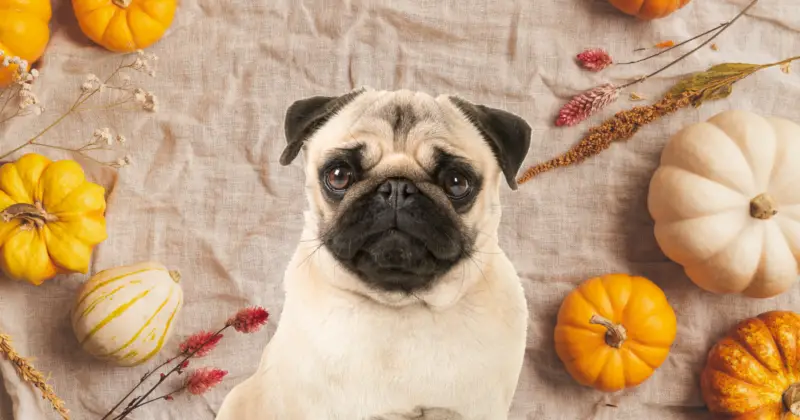
Pumpkin offers various health benefits for your Pug, making it an excellent addition to their diet. It is particularly valuable for their digestive system due to its high fiber content. Pumpkin can help ease constipation by promoting regular bowel movements and alleviate mild diarrhea by adding bulk to their stool source.
The fiber content in pumpkin also aids in weight management, allowing your Pug to feel fuller for longer periods and maintain a healthy weight. Incorporating pumpkin into their meals can significantly improve their overall health.
Pumpkin is also rich in antioxidants, which help protect your Pug’s body against cellular damage from free radicals. These antioxidants can support their immune system in fighting off diseases and infections while keeping them healthy.
In addition to benefiting your Pug’s digestive system and immune health, pumpkin can positively impact their skin and coat. The high water content and zinc and vitamin A presence in pumpkin promote a shiny, lustrous coat source. Consuming pumpkin can also lead to less skin flaking, decreasing the amount of hair shedding on your furniture and clothing.
Lastly, while not specifically studied in Pugs, pumpkin may provide general urinary health benefits for dogs. The high water content helps maintain hydration, possibly reducing the risk of urinary tract issues. However, always consult with your veterinarian before using pumpkin to address any specific urinary concerns.
So, incorporating pumpkin into your Pug’s diet can provide numerous health benefits, from digestive support to enhancing their skin and coat. Although pumpkin is not a magic remedy for every ailment, it can undoubtedly contribute positively to your Pug’s overall well-being.
Potential Risks of Feeding Pumpkin to Pugs

Feeding pumpkin to your pug can provide some health benefits, such as fiber and essential vitamins. However, you should know the potential risks associated with feeding pumpkin to keep your pug healthy and safe.
It’s essential to ensure that the pumpkin you give to your pug is 100% pure and free from harmful additives or spices. Canned pumpkin pie filling, for example, may contain sugar and nutmeg, both of which can be dangerous for your dog. High sugar content may lead to weight gain and diabetes, while nutmeg is toxic to dogs.
Pumpkin contains essential minerals such as zinc, copper, and manganese. Although these minerals are beneficial when consumed moderately, overfeeding pumpkin can lead to an imbalance. For instance, high levels of copper can cause harm to the liver, while too much manganese can interfere with the absorption of other essential nutrients in your pug’s diet.
Though pumpkin is low in cholesterol, monitoring your pug’s overall diet is crucial. High cholesterol intake can cause issues like obesity and heart problems. Ensuring that pumpkin is only a small part of a balanced diet can minimize these risks.
Check out this video:
Lastly, while pumpkin is generally safe for most dogs, some pugs may have individual allergies or sensitivities. Keep an eye on your pug for symptoms such as vomiting, diarrhea, or skin reactions after feeding them pumpkin. If you observe any adverse reactions, discontinue feeding pumpkin immediately and consult your veterinarian.
To minimize the potential risks of pumpkin for your pug, stick to moderate portions, opt for plain cooked or canned pumpkin, and prioritize a balanced diet that meets your pug’s nutritional needs.
Checklist for Feeding Pumpkin to Pugs

Feeding pumpkin to your pug can be a beneficial addition to their diet, as it is safe and holds many health benefits, such as aiding digestion and weight management, as mentioned by PetMD. However, you should take a few precautions to ensure that your dog enjoys the benefits safely. Here is a checklist to keep in mind while incorporating pumpkin into your pug’s diet.
1. Consult with a veterinarian: Before introducing pumpkin or any new food to your pug’s diet, speak to your veterinarian. They can guide you on the appropriate quantity and frequency for feeding pumpkin, considering your pug’s health, age, and nutritional needs.
2. Choose the right pumpkin form: Plain canned pumpkin is the safest option for your pug, as it lacks any additives, sugars, or spices that can harm your pet. Avoid feeding them pumpkin pie filling or the actual pumpkin pie itself, as they contain unhealthy ingredients, as noted by Native Pet.
3. Feed in moderation: Although there are numerous benefits to feeding your pug pumpkin, it is essential to feed it in moderation. Overfeeding can lead to digestive issues or even an imbalanced diet. Remember that treats and snacks, including pumpkin, should only make up a small portion of your pug’s overall diet.
4. Incorporate pumpkin into recipes: You can include pumpkin into various dog-friendly recipes or snacks, ensuring that your pug meets its nutritional needs while enjoying the treat. Combining pumpkin with other safe ingredients will help keep your pug’s diet diverse and exciting.
5. Monitor your pug’s reaction: Like any other new food introduced to your pug’s diet, carefully observe their reaction after consuming pumpkin. Stop feeding pumpkin and consult your veterinarian immediately if you notice any unusual behavior or adverse reactions in your pug.
By considering the points mentioned in this checklist, you can safely add pumpkin to your pug’s diet, offering them a nutritious and tasty treat. Always consult with your veterinarian when introducing new foods to ensure your pug maintains optimal health.
The Way to Serve Pumpkin to Pugs
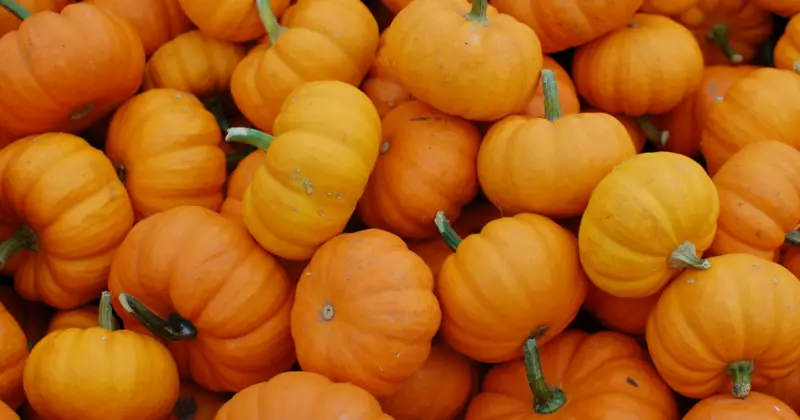
When it comes to serving pumpkin to your pug, you can use both fresh and canned pumpkin. Keep in mind that canned pumpkin should be plain, without any added sugar, spices, or preservatives. Fresh pumpkin can be cooked by roasting or boiling before you serve it to your furry friend.
Preparing fresh pumpkin involves a few simple steps. First, preheat your oven to 350 degrees. Lay the pumpkin on its side on a non-slip cutting board and cut off the top with the stem. Place the now-flat side of the pumpkin down and peel the skin using a knife or potato peeler. Cut the pumpkin in half and remove the seeds – you can either discard them or save them for later.
For roasting fresh pumpkin, cut the pumpkin into small cubes and place them on a baking sheet lined with parchment paper. Roast the pumpkin in the preheated oven for approximately 25-30 minutes or until it’s soft. Allow it to cool down before serving it to your pug.
Boiling pumpkin is another option. Dice the peeled pumpkin into small cubes, place them into a pot, cover them with water, and bring to a boil. Reduce the heat and let it simmer until the pumpkin is soft. Once it’s cooked and cooled, you can mash it or serve the pumpkin cubes directly to your pug.
When using canned pumpkin, make sure it’s plain, without any added sugars or spices. Simply add one-to-two tablespoons of canned pumpkin to your pug’s regular food to provide them with pumpkin’s nutritional benefits.
In both cases, make sure to monitor your pug’s reaction to the new addition to their diet. Every dog is different, and it’s essential to observe if your pug enjoys the pumpkin and if it causes any digestive issues.
Although pumpkin seeds can be a healthy snack for humans, it’s best to avoid giving them to your pug. If you decide to serve pumpkin seeds, ensure they’re unseasoned, roasted, and ground before incorporating them into your pug’s meal in small quantities.
Following these methods to serve and prepare pumpkin provides your pug with a nutritious and enjoyable treat. The added fiber and vitamins in pumpkin can help improve your pug’s overall health, making it a great addition to their diet.
Additions and Alternatives to Pumpkin

When incorporating pumpkin into your pug’s diet, it is important to remember not to use pumpkin pie filling, as it contains added spices and salt that can be harmful to your dog. Instead, opt for pure canned pumpkin or fresh pumpkin that has been cooked and cooled.
Besides pumpkin, you can include several other nutritious options in your pug’s diet. If you are looking for different vegetables to add, consider broccoli or carrots, as they are excellent sources of vitamins and fiber. Watermelon and cantaloupe can also make a delicious treat for your pug—make sure to remove any seeds before feeding.
Regarding protein sources, lean meats such as chicken or turkey are great choices. Wild-caught fish and eggs can also provide essential nutrients for your pug. However, be mindful of portion sizes, as too much protein can lead to weight gain, especially for pugs who are prone to obesity.
Finally, don’t underestimate the power of some herbs and spices in your dog’s diet. Turmeric, ginger, garlic powder, cinnamon, and oregano can all help support your pet’s health when used in moderation. Just make sure to always consult your veterinarian before introducing new foods or supplements to your pug’s diet.
Precautions to Take When Feeding Pumpkin to Pugs
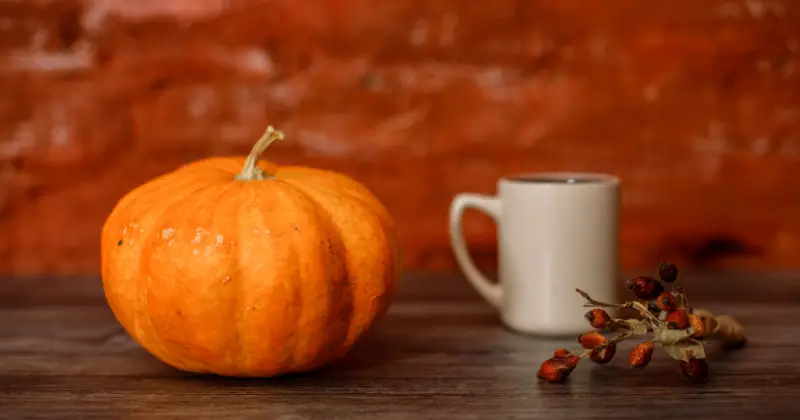
Pumpkin can be a healthy treat for your Pug, but taking some precautions is essential to ensure their safety. First, be aware of the presence of xylitol, which is a sugar substitute that can be toxic to dogs. Make sure to choose a pumpkin product that does not contain this harmful ingredient.
Remove all seeds before feeding pumpkin to your Pug, as they can be a choking hazard. Seeds also contain fatty acids that can be difficult for your Pug to digest, leading to gastrointestinal issues like vomiting. It’s best to provide them with pure, seedless pumpkins.
Keep in mind that moderation is crucial. Although pumpkin can be a healthy treat, overfeeding can cause problems. Treats should account for no more than 10% of your Pug’s daily intake. Remember to balance their diet with other fruits, vegetables, and essential nutrients.
When feeding pumpkin to your Pug, you can choose between fresh and canned pumpkin. However, avoid giving them pumpkin pie filling, as it contains added sugars and spices that could be harmful. Additionally, be cautious of the skin, which can be challenging for your Pug to digest. Stick to the soft, cooked pumpkin flesh for a safer option.
In summary, when fed appropriately, pumpkin can be a beneficial treat for Pugs. Be mindful of potential hazards like xylitol, seeds, and skin, and remember to provide pumpkin in moderation, ensuring that your Pug maintains a balanced diet.
Conclusion
In summary, pugs can eat pumpkin, providing various health benefits for your furry friend. Pumpkin is rich in fiber, which can improve your pug’s digestion and help with weight management, as it can help them feel fuller without increasing their calorie intake [^1^] (https://blackpugsite.com/can-pugs-eat-pumpkin/). To incorporate pumpkin into your pug’s diet, try replacing a small portion of their regular food with canned pumpkin.
Other benefits of pumpkin for dogs include its nutritional value and low side effects [^2^] (https://topdogtips.com/can-dogs-eat-pumpkin/). Remember to choose a high-quality, small-breed dry dog food specifically designed for pugs, as it can meet their specific nutritional needs [^3^] (https://smallanimaladvice.com/what-can-pugs-eat/). Introducing a variety of fruits and vegetables in their diet can also add important nutrients and flavor to their meals.
Always keep in mind that moderation is key. While pumpkin is a healthy addition to your pug’s diet, it’s essential not to overdo it. Monitor your pug’s overall health and consult your veterinarian if you have concerns or questions about implementing pumpkin into their diet. By maintaining a balanced and nutritious diet for your pug, you can support their well-being and overall happiness.
Frequently Asked Questions: Can Pugs Eat Pumpkin
Is pumpkin beneficial for pugs?
Yes, pumpkin can be beneficial for pugs, as it is a good source of fiber, vitamins, and minerals. Adding small amounts of pumpkin in their regular diet can help with weight management and digestive health. It can also help them feel fuller without increasing their calorie intake, which is important for pugs prone to obesity.
How much pumpkin can I give to my pug?
You can give your pug small amounts of pumpkin. However, it would be best to consult your veterinarian to determine the appropriate serving size for your specific pug. Since each dog is unique, age, weight, and overall health should be taken into consideration.
Should pugs consume raw or cooked pumpkin?
When feeding pumpkin to your pug, it is best to give them cooked and pureed pumpkin without added sugars or spices. Raw pumpkin can be difficult for dogs to digest. Cooked pumpkin, on the other hand, is easier for them to process and can provide the most benefits.
Is canned pumpkin safe for pugs?
Canned pumpkin can be safe and convenient for pugs as long as it’s 100% pure pumpkin without any added sugars or spices. Make sure to avoid canned pumpkin pie mix, as it contains added sugars and ingredients that could be harmful to your pug.
Can pumpkin help pugs with upset stomach?
Pumpkin can indeed help pugs with mild cases of stomach upset, such as constipation or diarrhea, due to its high fiber content. However, if your pug is experiencing severe digestive issues, it’s essential to consult with your veterinarian, as it could be a sign of a more serious health problem.
How often can I give pumpkin to my pug?
You can feed your pug pumpkin occasionally as a treat or supplement their regular diet with small amounts. It’s crucial to monitor your pug’s reaction to the pumpkin and adjust the frequency accordingly. If you’re unsure about how often to offer pumpkin, consult with your veterinarian for personalized advice.


